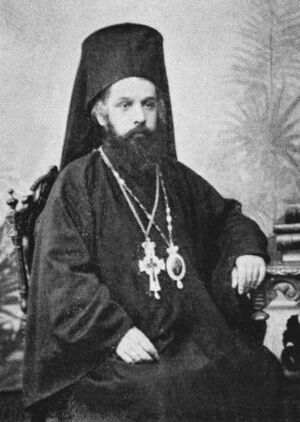Constantine VI of Constantinople facts for kids
Quick facts for kids |
|
|---|---|
| Ecumenical Patriarch of Constantinople | |

Patriarch Constantine VI as a bishop, 1906
|
|
| Church | Ecumenical Patriarchate of Constantinople |
| In Office | 17 December 1924 – 22 May 1925 |
| Predecessor | Gregory VII of Constantinople |
| Successor | Basil III of Constantinople |
| Personal details | |
| Born | 1859 |
| Died | 28 November 1930 |
Constantine VI (born 1859 – died November 28, 1930) was a very important leader in the Eastern Orthodox Church. He served as the Ecumenical Patriarch of Constantinople from December 17, 1924, to May 22, 1925. This role is like being the spiritual head for many Orthodox Christians around the world.
Contents
Who Was Patriarch Constantine VI?
Constantine VI was born in 1859 in a place called Syge, which was near the city of Bursa. He studied at the Halki seminary, which is a famous school for church leaders. After his studies, he became a bishop in different cities.
His Journey in the Church
Constantine started his church career as a bishop in Rodosto in 1896. Later, he became a senior bishop, known as a metropolitan, in several places:
- Vella and Konitsa in 1899
- Trebizond in 1906
- Cyzicus in 1913
- Derkoi in 1922
These roles prepared him for a very important position.
Becoming Patriarch and Facing Challenges
After Patriarch Gregory VII passed away, Constantine became the temporary leader. On December 17, 1924, he was chosen to be the new Ecumenical Patriarch. He was officially given this role on the same day.
However, there was a big problem. The Turkish government believed Constantine should be sent to Greece. This was part of a deal called the population exchange between Greece and Turkey. This deal meant that many Greeks living in Turkey had to move to Greece, and many Turks living in Greece had to move to Turkey.
Constantine argued that the Patriarchate (the church's main office) was supposed to be an exception to this rule. But his arguments didn't work. On January 30, 1925, he was forced to leave Constantinople and travel to Greece by train.
Diplomatic Efforts and His Resignation
The Greek government, led by Prime Minister Andreas Michalakopoulos, tried very hard to help Constantine. They wanted him to be allowed to return to Constantinople. However, they were worried that the situation might get worse, so they suggested he retire to Mount Athos.
Constantine first went to Thessaloniki, where many people welcomed him. From there, he tried to get help from the League of Nations (an international group that tried to keep peace). He wanted to go back to Constantinople, but his efforts were not successful.
Some military leaders in Greece even wanted to start fighting with Turkey again because of this issue. The Greek government tried to get other countries involved. Even Eleftherios Venizelos, a former Greek Prime Minister, was asked for help. Venizelos supported the government's goal but disagreed with the church's decision to insist on Constantine's election.
On February 4, 1925, the Turkish government officially approved his expulsion. On February 11, 1925, Greece asked the League of Nations for help.
Eventually, Turkey agreed not to force other Greek bishops to leave. Because of this, Greece stopped asking the League of Nations for help. They also encouraged Constantine to resign, promising him a good life in Greece. Finally, Constantine officially resigned on May 22, 1925.
Later Life and Legacy
After resigning, Constantine lived for a while in Chalcis. He then moved permanently to Nea Filadelfeia, a suburb of Athens. The Greek government gave him a house there.
He passed away on November 28, 1930, and was buried in the First Cemetery of Athens. Many years later, in 2011, his remains were moved back to Istanbul. On March 6, 2011, he was reburied near other Patriarchs at the Church of St. Mary of the Spring.

